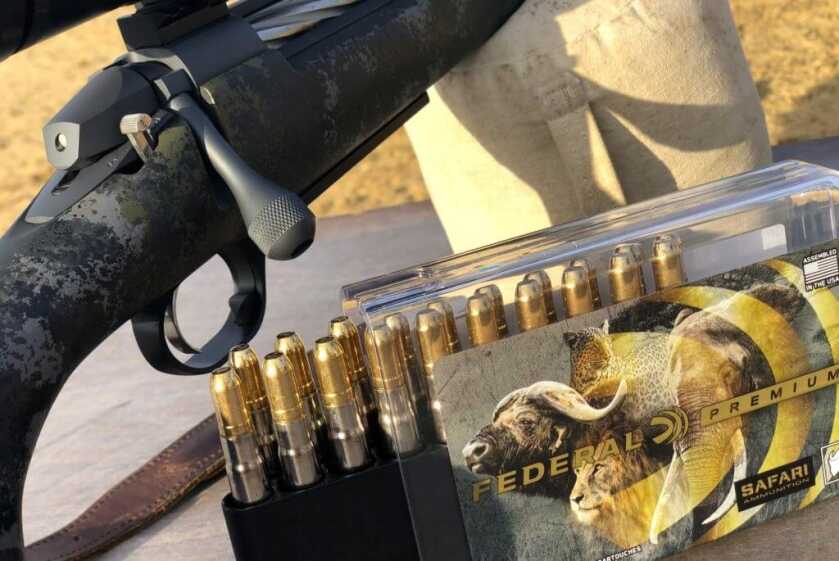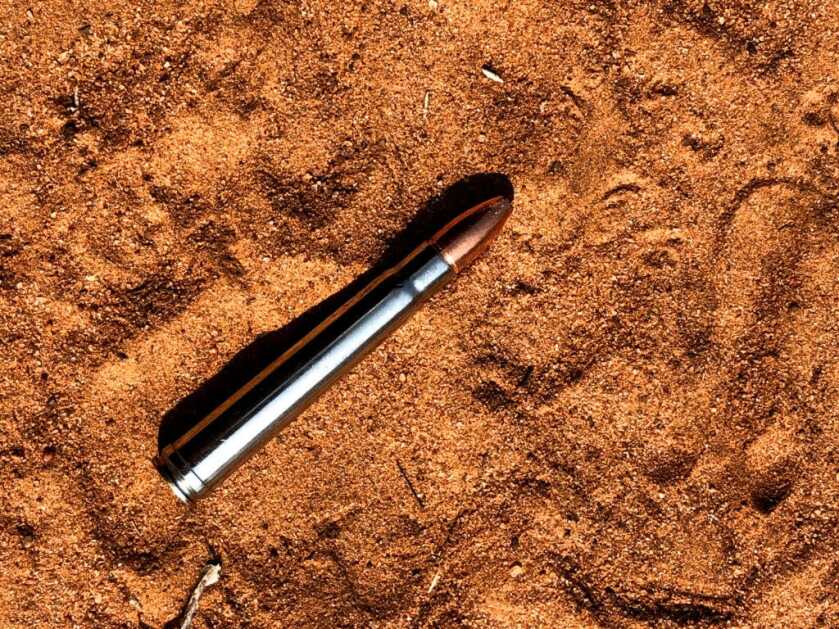
The author is presented with a shot at a giant buffalo, but the shooting light is poor and there is a screen of twigs in the way. Should he take the shot?
Estimated reading time: 10 minutes
HUNTING CAPE BUFFALO
A long week of tracking and hunting Cape Buffalo lay behind us; a week of sorting through the muddy nighttime tracks left around a pan – the African version of a small lake or pond – and following the freshest of those tracks into the Mopane and Sandveldt jungle. A week of staying ever alert for elephants, especially cows with calves. The mamas have no sense of humor and will do their best to annihilate unwary hunters. They like to stomp folks to jelly on the ground or use their trunk to grasp poor souls by a limb and beat them against a convenient tree. The thought has a way of inspiring you to pay attention to your surroundings and keep your rifle handy.
Every morning we checked around the pans and along dirt two-tracks, searching for the fresh tracks of buffalo. In the afternoon we might look again, often dragging a small bushy tree behind the Land Cruiser to wipe the dirt roads clean of signs, creating a fresh slate for the morning hunt. We would saw or hack trees and limbs from the roadways, littered there by elephants as they browsed their perpetual way toward another massive belly full of feed. They were irresponsible in their methods, pushing trees and breaking limbs every place, regardless of the inconvenience they caused.
LOCAL TECHNIQUE
The local trackers each carried a curious machete/billhook-shaped “Ponga”, using it for everything from chopping trees to digging holes or pointing out fresh tracks. They could cut their way through a thigh-sized limb in short order, swinging the Ponga with the practiced ease of a competition-level lumberjack. When I tried I didn’t have so much luck.

Hunting in Africa is fascinating, and I was thoroughly enjoying myself as another day dawned and we took up a fresh buffalo trail. This time there were only three, but the tracks looked big like old bulls had made them. As we walked, following the trackers along the sign, my mind drifted back to the evening before. We had followed a herd of bulls all afternoon, finally coming up with them just as the sun set over the distant hills. Crawling on our bellies, we closed the distance to just under 100 yards and set up against the boles of a tree clump. Ian, my PH, studied the buffalo for what seemed like forever before proclaiming them all too ugly or too young to shoot, even the impossibly wide one whose giant horns spanned perhaps 43 inches.
MAGICAL ENCOUNTER
Then Ian did something remarkable; he stood and allowed the bulls to see us. Strangely, the normally-spooky buffalo simply looked us over and then formed a large semi-circle, heads high and facing us as we walked obliquely along, inspecting their ranks. All those massive bulls standing regal, unafraid and dangerous, were an incredible sight. They had finally turned, to thunder away into the growing dark. It was a magical moment, and one that Ian later told me was the finest buffalo encounter he’s ever had in Mozambique.
My rifle felt good on my shoulder as I followed Ian through the Bush, remembering those ranks of big bulls. I hoped we would come up on some more today, and that this time there would be an old one, wide and massive, with deep, curving horns. The tracks led on, and we walked deeper into the Sandveldt.

RIFLE, OPTICS, AND AMMO
For this hunt, I was carrying a Bergara Canyon model rifle, chambered in .375 H&H and sporting a 22-inch taper-fluted #4 contour stainless cerakoted barrel, carbon fiber stock, and a perfectly crisp trigger that I adjusted to 2.5 pounds. It’s a beautifully balanced rifle that handles like a million bucks and is ideally configured for shooting from field positions. Topped with a Zeiss 1-8X24 V8 riflescope, it’s an excellent setup for hunting dangerous game in heavy brush country. For a binocular I carried my standard Zeiss 10X42 Victory RF bino/rangefinder unit, comfortably secured to my chest in a Badlands bino harness.
I was directed to come prepared with both soft point and solid bullets, so I chose Federal Premium’s 300-grain Safari Swift A-Frame load with a velocity of 2450 fps for my “soft”, and their 300-grain Trophy Bonded Sledgehammer load going 2440 fps for my “solid” load. Both loads shot into the same point of impact at 100 yards, and provided 1-moa accuracy. I was to load my rifle with the soft load when tracking and stalking buffalo and for the initial shot(s), and then switch to the solids when the time came to approach a downed animal or follow up on a wounded one.

THE HUNT
We follow the tracks of the three bulls deeper and deeper into the Veldt. The sun rolls across the sky and dusk searches us out, reaching with long, shadowy fingers into the Sandveldt. Finally, just as we are about to call off the hunt and head for the truck, Ian spots the bulls ahead of us. They are buried in thick brush 50 yards distant, and difficult to see. Finally, they shuffle forward a bit, and Ian tells me two of the bulls are old and one is young. We still don’t know if they are big or not. I’ve seen deeply curved horns on one bull, but can’t tell if he’s wide, or old with hard bosses.
The breeze shifts just a bit and the bulls get nervous, moving slowly away and to our right. The bull with the deeply curved horns is in the lead. I step on some crunchy leaves and he stops, swinging his massive head to look at us, perhaps 90 yards distant. We see then the giant, wide, deeply curved horns and Ian sets the sticks and tells me to shoot the bull.
I steady my rifle over the shooting sticks and plaster the crosshairs onto the bull’s vitals. A thin screen of leaves and twigs partially obscure his quartered-to shoulder and I worry, uncomfortable about shooting through it. I tell Ian and ask if he still wants me to shoot. His answer is emphatic “Yes. You must shoot now”.

TAKE THE SHOT?
Put yourself in my footprints, deep in the Bush of Mozambique. You’ve traveled halfway around the globe, flown on a turbulent-tossed bush plane, and braved the elephants and the elements. You’ve walked days on end following the spoor of buffalo. Finally, you have a shot opportunity at a massive bull, but similar to the last opportunity you had (see previous article “Black Death In The Bush”), which you passed, there is intervening brush.
This time, however, the screen of twigs and leaves is thinner, and the distance is less. You can see the bull clearly, and your rifle is steady across the shooting sticks. Ian, your trusty PH, is adamant that you should shoot this bull, and now.
Would you take the shot?

HERE’S WHAT HAPPENED (TRUE STORY)
I took the shot. My crosshairs were steady on the point of the bull’s shoulder, and imbued with a sense of urgency I held them firm and pressed the trigger.
I hit the bull solidly and he lurched away, running hard through the Bush. Muscle memory slammed a fresh cartridge into the breech and I swung my crosshairs onto the massive black beast and pressed the trigger once more. Then the buffalo were gone and the woods became oddly silent. I’d hit the bull hard, I was certain of that. Pausing, I cleared my rifle and loaded solids into the magazine and chamber. Just then, a mournful bawl echoed through the Veldt. It was the legendary death bellow of the Cape buffalo.
We approached the downed bull, rifles at the ready. Ian had me place the standard “insurance shot” through the bull’s heart. And then it was over. Night fell, and as we loaded the buffalo into the truck a lion paced downwind in the darkness, hoping for a feast. It was the perfect end to a fantastic hunt.

CONCLUSION
If you have read my previous Take The Shot article “Black Death In The Brush”, you’re familiar with the fact that I am uncomfortable shooting at game if there is any intervening brush at all – even the slightest leaves or tiniest twigs. This probably stems from a long history of bowhunting, because it’s impossible to shoot an arrow accurately through any kind of obstruction. However, while hunting in Mozambique I was forced to come to terms with the fact that occasionally it is necessary to take an obstructed shot.
READ MORE: Top 10 Exotic Hunts That Should Be on Your Bucket List
Fortunately, the big 300-grain .375 Federal Premium bullets I was shooting took no notice of the obstructions and killed fast and clean. My first shot struck the bull squarely on the point of the right shoulder and stopped under the skin, at the last rib on the opposite side. The second shot, taken at the running bull, struck at the last rib on the right side and stopped under the skin at the point of the left shoulder. The bullets had crossed paths in the center of the vitals.
In my opinion, there are two key elements that must be in place before shooting through brush: first, the screen of brush must be thin and light, and close to the target so the projectile doesn’t have much distance wherein to deflect. Secondly, a big, heavy, slow-moving bullet should be used; one that won’t fragment upon contact with a light twig or leaf. Certainly, it is best to avoid shooting through any intervening brush, but as I learned in Mozambique, under the right circumstances it is doable.
Would you take the shot? Let me know what you think in the comment section below.
*** Buy and Sell on GunsAmerica! ***


did you steal this animal too?